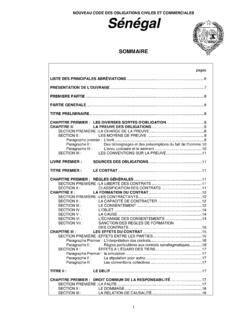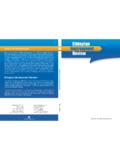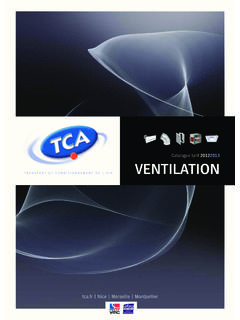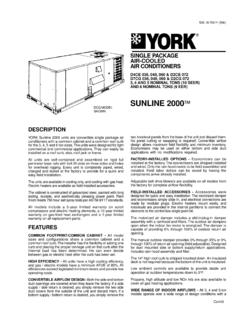Transcription of Risk%Adjustment,%HCC%Model,%&% …
1 Risk adjustment , HCC Model, & Stars Ra8ngs 101 An Overview for Coders & Providers Risk adjustment (RA) Risk adjustment is a method of analysis using diagnoses for nancial forecas8ng that has been growing in popularity in healthcare Medicaid plans began using Risk adjustment modeling in 1996 and has con8nued to update that model Medicare Advantage Plans have been using the HCC/ Risk adjustment model since 2004 and is expanding the program Commercial Plans are now looking at Risk adjustment as a valuable method to iden8fy and plan for high risk pa8ents 3/17/13 ionHealthcare, LLC All rights reserved. For educa8on & discussion purposes. PermiUed use via contractual agreement/purchase. 2 RA & A ordable Care Act The A ordable Care Act calls for a risk adjustment program that aims to eliminate incen8ves for health insurance plans to avoid people with pre- exis8ng condi8ons or those who are in poor health.
2 Risk adjustment ensures that health insurance plans have addi8onal money to provide services to the people who need them most by providing more funds to plans that provide care to people that are likely to have high health costs. Insurance plans then compete on the basis of quality and service, and not on the basis of whether they can aUract healthy people (Larsen, 2011) 3/17/13 ionHealthcare, LLC All rights reserved. For educa8on & discussion purposes. PermiUed use via contractual agreement/purchase. 3 Di erent Programs, Same Goal Whether Risk adjustment is being u8lized for Medicaid, Medicare, or Commercial pa8ents, the main ingredients used are Diagnosis Codes (ICD codes) Diagnoses are collected and their speci city drives risk score or categoriza8on The worse, or more serious a condi8on, or diagnosis, the higher the risk scoring Risk Scores either a ect incoming payment or the future nancial forecas8ng for each pa8ent 3/17/13 ionHealthcare, LLC All rights reserved.
3 For educa8on & discussion purposes. PermiUed use via contractual agreement/purchase. 4 Why It MaUers For Medicare Advantage Plans Risk adjustment (RA) iden8 es pa8ents who may need disease management interven8ons and RA establishes the nancial allotment allowed from CMS toward the annual care of each pa8ent; with more dollars allocated for those with higher risk scores For Medicaid and Commercial Plans Risk adjustment (RA) iden8 es pa8ents who may need disease management interven8ons and RA establishes the overall state of the popula8on by aggrega8ng diagnoses; which assists in nancial forecas8ng for future medical need 3/17/13 ionHealthcare, LLC All rights reserved. For educa8on & discussion purposes. PermiUed use via contractual agreement/purchase. 5 General RA Guidelines These programs operate on similar rules and guidelines to include: Speci c diagnoses must be documented in a face.
4 To- face visit by the trea8ng licensed provider (showing creden8als: MD, DO, PA, NP, OT, CRNA, MSW, and similar master's level providers) and the documenta8on must be signed by the trea8ng provider to be accepted Diagnoses must be clearly stated on the DOS (Date Of Service) as a current problem if audited Diagnoses must be documented each year, ongoing as each year is evaluated without historical context in uence 3/17/13 ionHealthcare, LLC All rights reserved. For educa8on & discussion purposes. PermiUed use via contractual agreement/purchase. 6 Signi cance to Providers Providers have long aUempted to establish the seriousness and severity of the pa8ents they treat through the use of E&M CPT codes Higher level E&M codes iden8fy serious encounters, u8lizing more medical decision making, and are reimbursed at a higher rate In Risk adjustment scenarios, these CPT codes have no signi cance Instead, speci c diagnosis codes communicate the seriousness of medical decision making 3/17/13 ionHealthcare, LLC All rights reserved.
5 For educa8on & discussion purposes. PermiUed use via contractual agreement/purchase. 7 Signi cance to Providers Using speci c ICD Diagnosis Codes will help convey the true seriousness of the condi8ons being addressed in each visit Documen8ng these carefully involves two main focal points: Iden8fying the Diagnosis as a current or ongoing problem as opposed to a PMH (Past Medical History) or previous condi8on Choosing the most speci c Diagnosis Code while also being sure documenta8on supports it 3/17/13 ionHealthcare, LLC All rights reserved. For educa8on & discussion purposes. PermiUed use via contractual agreement/purchase. 8 Origins of Medicare Advantage & the HCC Model Sub8tle A of the Balanced Budget Act of 1997 created Medicare Choice for pa8ents. This allowed pa8ents to choose the original Medicare FFS program or a Medicare + Choice program.
6 The Medicare Moderniza8on Act of 2003 changed Medicare + Choice to Medicare Advantage The new Medicare risk adjustment model was gradually phased into Medicare advantage payment calcula8ons star8ng in 2004 (with full implementa8on in 1/2007) Developed by researchers at RTI Interna8onal, Boston University and Harvard medical school, Hierarchical Condi8on Categories, uses ambulatory and inpa8ent diagnosis to create a valid risk adjustment methodology to help predict individual expenditure varia8on among Medicare pa8ents 3/17/13 ionHealthcare, LLC All rights reserved. For educa8on & discussion purposes. PermiUed use via contractual agreement/purchase. 9 The HCC Model is Ever- . Changing The original DCG/HCC model in 2000 iden8 ed 804 costly diagnosis groups, mapped to 189 HCC codes Created a repor8ng model for reimbursement based on ICD codes within families of condi8ons.
7 (Hierarchal Categories) There are 2,944 ICD codes carrying Part C HCC value. The program began with over 3,000 in 2004 There are 1,475 ICD codes carrying Part D HCC value. The program began with over 3,000 in 2004 978 ICD codes carry both Part C and Part D HCC value. The program began with ~ 1500 in 2004 Major Changes are due for 2014 (new HCC's, split values, etc.) 3/17/13 ionHealthcare, LLC All rights reserved. For educa8on & discussion purposes. PermiUed use via contractual agreement/purchase. 10 How ICD Codes Carry Value Most of the ICD diagnosis codes which are in the model are chronic condi8ons Risk adjustment is based on adjus8ng the es8mated risk of each pa8ent based on known diagnoses Part C HCC (HCC- C) are those diagnoses which are costly to manage from a medical perspec8ve Part D HCC (HCC- D) are those diagnoses which are costly to manage from a prescrip8on drug perspec8ve Some diagnoses carry both part D and Part D value These ICD codes have a RAF (risk adjustment factor), similar in concept to the RVU value of procedure codes 3/17/13 ionHealthcare, LLC All rights reserved.
8 For educa8on & discussion purposes. PermiUed use via contractual agreement/purchase. 11 HCC Hierarchal Categories Used 2014 Hierarchal Categories in the HCC Model INFECTION BLOOD CEREBROVASCULAR COMPLICATIONS DISEASE NEOPLASM SUBSTANCE VASCULAR TRANSPLANT ABUSE DIABETES PSYCHIATRIC LUNG OPENINGS METABOLIC SPINAL EYE AMPUTATION LIVER NEUROLOGICAL KIDNEY DISEASE INTERACTIONS GASTROINTESTINAL ARREST SKIN DISABLED/DISEASE INTERACTIONS MUSCULOSKELETAL HEART INJURY 3/17/13 ionHealthcare, LLC All rights reserved. For educa8on & discussion purposes. PermiUed use via contractual agreement/purchase. 12 If this HCC is found **2013 Disease Group Label** Then Drop these HCC s: 5 OpportunisMc InfecMons 112 7 MetastaMc Cancer and Acute Leukemia 8, 9, 10 8 Lung, Upper DigesMve Tract, and Other Severe Cancers 9, 10 9 LymphaMc, Head and Neck, Brain and Other Major Cancers 10 15 Diabetes with Renal ManifestaMons or Peripheral Circulatory ManifestaMon 16, 17, 18, 19 16 Diabetes with Neurologic or Other Speci ed ManifestaMon 17, 18, 19 17 Diabetes with Acute ComplicaMon 18, 19 18 Diabetes with Ophthalmologic or Unspeci ed ManifestaMons 19 25 End Stage Liver Disease 26, 27 26 Cirrhosis of Liver 27 51 Drug/Alcohol Psychosis 52 54 Schizophrenia 55 67 Quadriplegia/Other Extensive Paralysis 68, 69, 100, 101, 157 68 Paraplegia 69, 100, 101, 157 69 Spinal Cord Disorders/Injuries 157 77 Respirator Dependence/Tracheotomy Status 78.
9 79 78 Respiratory Arrest 79 81 Acute Myocardial InfarcMon 82, 83 82 Unstable Angina and Other Acute Ischemic Heart Disease 83 95 Cerebral Hemorrhage 96 100 Hemiplegia/Hemiparesis 101 104 Vascular Disease with ComplicaMons 105, 149 107 CysMc Fibrosis 108 111 AspiraMon and Speci ed Bacterial Pneumonias 112 130 Dialysis Status 131, 132 131 Renal Failure 132 148 Decubitus Ulcer of Skin 149 154 Severe Head Injury 75, 155 161 TraumaMc AmputaMon 177 If this HCC is found **2014 Disease Group Label** Then Drop these HCC s: 8 Metasta8c Cancer and Acute Leukemia 9,10,11,12 9 Lung and Other Sever Cancers 10,11,12 10 Lymphoma and Other Cancers 11,12 11 Colorectal, Bladder, and Other Cancers 12 17 Diabetes with Acute Complica8ons 18,19 18 Diabetes with Chronic Complica8ons 19 27 End- Stage Liver Disease 28,29,80 28 Cirrhosis of Liver 29 46 Severe Hematological Disorders 48 54 Drug/Alcohol Psychosis 55 57 Schizophrenia 58 70 Quadriplegia 71,72,103,104,169 71 Paraplegia 72,104,169 72 Spinal Cord Disorders/Injuries 169 82 Respirator Dependence/Tracheostomy Status 83,84 83 Respiratory Arrest 84 86 Acute Myocardial Infarc8on 87.
10 88 87 Unstable Angina and Other Acute Ischemic Heart Disease 88 99 Cerebral Hemorrhage 100 103 Hemiplegia/Hemiparesis 104 106 Atherosclerosis of the Extremi8es with Ulcera8on or Gangrene 107,108,161,189 107 Vascular Disease with Complica8ons 108 110 Cys8c Fibrosis 111,112 111 Chronic Obstruc8ve Pulmonary Disease 112 114 Aspira8on and Speci ed Bacterial Pneumonias 115 134 Dialysis Status 135,136,137 135 Acute Renal Failure 136,137 136 Chronic Kidney Disease (Stage 5) 137 157 Pressure Ulcer of Skin with Necrosis Through to Muscle, Tendon, or Bone 158,161 Acceptable Provider Special8es CODE SPECIALTY CODE SPECIALTY CODE SPECIALTY 01 General Prac8ce 25 Physical Medicine & Rehabilita8on 67 Occupa8onal Therapist 02 General Surgery 26 Psychiatry 68 Clinical Psychologist 03 Allergy/Immunology 27 Geriatric Psychiatry 72 Pain Management 04 Otolaryngology 28 Colorectal Surgery 76 Peripheral Vascular Disease 05 Anesthesiology 29 Pulmonary Disease 77 Vascular Disease 06 Cardiology 33 Thoracic Surgery 78 Cardiac Surgery 07 Dermatology 34 Urology 79 Addic8on Medicine 08 Family Prac8ce 35 Chiroprac8c 80 LCSW 09 Interven8onal Pain Management (IPM) 36 Nuclear Medicine 81 Cri8cal Care (Intensivists)







